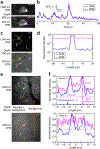In vivo three-photon imaging of activity of GCaMP6-labeled neurons deep in intact mouse brain
- PMID: 28218900
- PMCID: PMC6441362
- DOI: 10.1038/nmeth.4183
In vivo three-photon imaging of activity of GCaMP6-labeled neurons deep in intact mouse brain
Abstract
High-resolution optical imaging is critical to understanding brain function. We demonstrate that three-photon microscopy at 1,300-nm excitation enables functional imaging of GCaMP6s-labeled neurons beyond the depth limit of two-photon microscopy. We record spontaneous activity from up to 150 neurons in the hippocampal stratum pyramidale at ∼1-mm depth within an intact mouse brain. Our method creates opportunities for noninvasive recording of neuronal activity with high spatial and temporal resolution deep within scattering brain tissues.
Conflict of interest statement
COMPETING FINANCIAL INTERESTS
The authors declare no competing financial interests.
Figures


Similar articles
-
Two-photon activation and excitation properties of PA-GFP in the 720-920-nm region.Biophys J. 2005 Aug;89(2):1346-52. doi: 10.1529/biophysj.104.054502. Epub 2005 May 20. Biophys J. 2005. PMID: 15908572 Free PMC article.
-
Quantitative analysis of 1300-nm three-photon calcium imaging in the mouse brain.Elife. 2020 Jan 30;9:e53205. doi: 10.7554/eLife.53205. Elife. 2020. PMID: 31999253 Free PMC article.
-
Three-photon imaging of synthetic dyes in deep layers of the neocortex.Sci Rep. 2020 Oct 1;10(1):16351. doi: 10.1038/s41598-020-73438-w. Sci Rep. 2020. PMID: 33004996 Free PMC article.
-
Advanced observation of brain and nerve cells using two-photon microscopy with novel techniques.Microscopy (Oxf). 2023 Apr 6;72(2):144-150. doi: 10.1093/jmicro/dfac047. Microscopy (Oxf). 2023. PMID: 36130254 Review.
-
Focusing new light on brain functions: multiphoton microscopy for deep and super-resolution imaging.Neurosci Res. 2022 Jun;179:24-30. doi: 10.1016/j.neures.2021.11.011. Epub 2021 Nov 30. Neurosci Res. 2022. PMID: 34861295 Review.
Cited by
-
Long-working-distance high-collection-efficiency three-photon microscopy for in vivo long-term imaging of zebrafish and organoids.iScience. 2024 Jul 19;27(8):110554. doi: 10.1016/j.isci.2024.110554. eCollection 2024 Aug 16. iScience. 2024. PMID: 39184441 Free PMC article.
-
Spatio-temporal parameters for optical probing of neuronal activity.Biophys Rev. 2021 Feb 23;13(1):13-33. doi: 10.1007/s12551-021-00780-2. eCollection 2021 Feb. Biophys Rev. 2021. PMID: 33747244 Free PMC article. Review.
-
Label-free highly multimodal nonlinear endoscope.Opt Express. 2022 Jul 4;30(14):25020-25033. doi: 10.1364/OE.462361. Opt Express. 2022. PMID: 36237042 Free PMC article.
-
A 250 μm × 57 μm Microscale Opto-electronically Transduced Electrodes (MOTEs) for Neural Recording.IEEE Trans Biomed Circuits Syst. 2018 Dec;12(6):1256-1266. doi: 10.1109/TBCAS.2018.2876069. Epub 2018 Oct 15. IEEE Trans Biomed Circuits Syst. 2018. PMID: 30334768 Free PMC article.
-
Three-photon imaging of mouse brain structure and function through the intact skull.Nat Methods. 2018 Oct;15(10):789-792. doi: 10.1038/s41592-018-0115-y. Epub 2018 Sep 10. Nat Methods. 2018. PMID: 30202059 Free PMC article.
References
MeSH terms
Substances
Grants and funding
LinkOut - more resources
Full Text Sources
Other Literature Sources

